#livre de la vigne nostre seigneur
Text

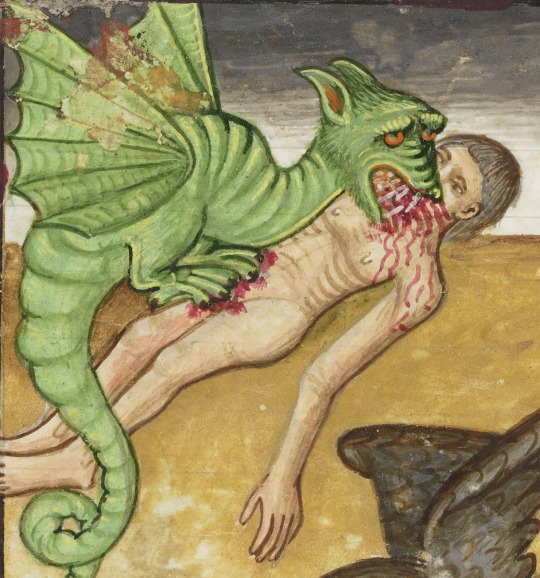
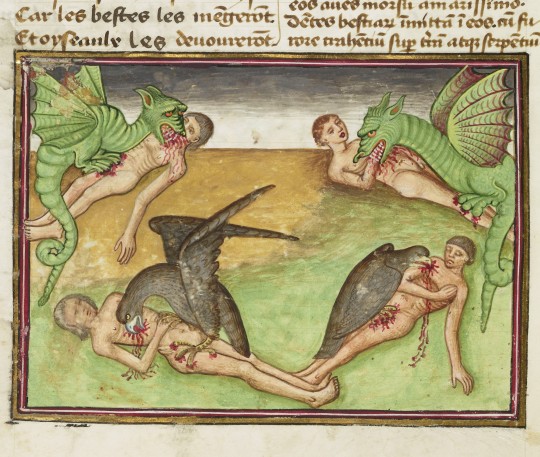
souls of the slothful being devoured by dragons and eagles in hell
in the "livre de la vigne nostre seigneur", france, c. 1450–1470
source: Oxford, Bodleian Library, MS. Douce 134, fol. 84v
#beautiful slothful boy with red lipstick you deserved better#15th century#medieval art#hell#dragons#livre de la vigne nostre seigneur#souls#violence
4K notes
·
View notes
Photo

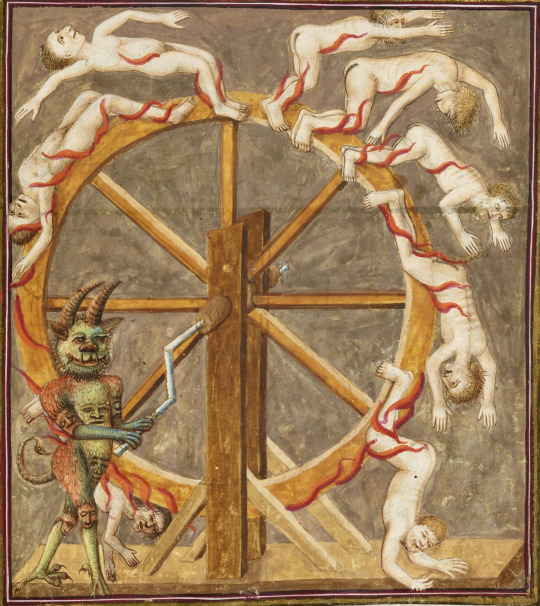
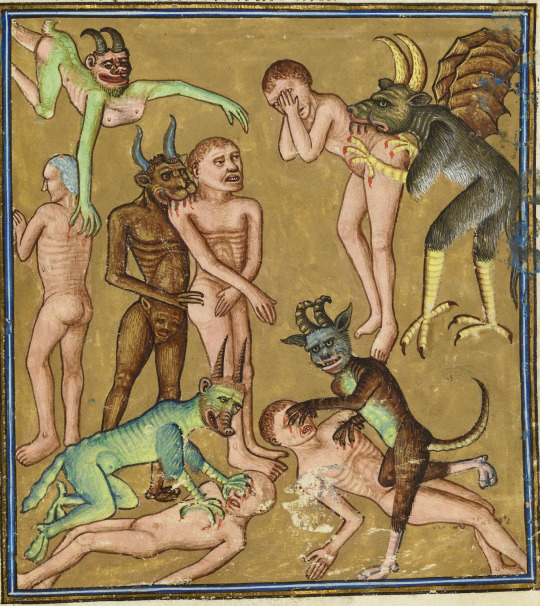


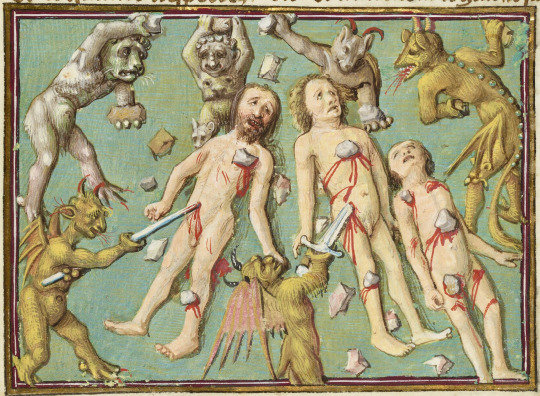
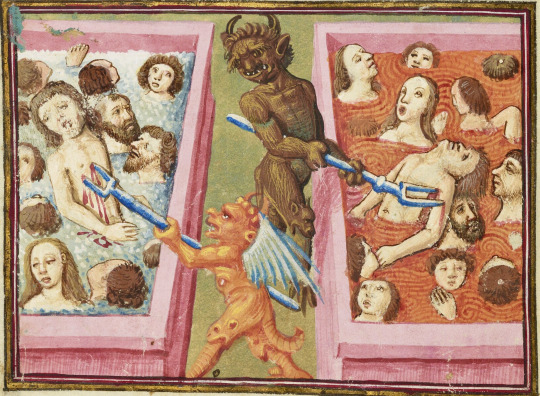
A 15th Century tour of Hell
Medieval monks had themselves one hell of a time imagining the demons awaiting sinners in Hell. The illustrations are from Livre de la Vigne nostre Seigneur (Bodleian MS. Douce 134), a treatise on the Antichrist, the last judgement, and Heaven and Hell.
1K notes
·
View notes
Photo

The Sun and the Moon, Livre de la Vigne nostre Seigneur, France, 1450-1470 (Bodleian Library, MS. Douce 134, fol. 49v)
[via @discardingimages]
225 notes
·
View notes
Text

French illuminated manuscript
Souls leaving the bodies of the dead in "livre de la vigne nostre seigneur" (ca. 1450–1470)
32 notes
·
View notes
Text

Las fauces del infierno. Manuscript Livre de la Vigne nostre Seigneur, France circa 1450-1470.
Jessica Biel
#fangledeities#jessica biel#medieval art#illuminated manuscript#hell#goddess#sacred art#art history#fashion photography#pinup#red carpet
36 notes
·
View notes
Text

Livre de la Vigne nostre Seigneur (Bodleian Library MS. Douce 134), fol. 30r (detail)
France, ca. 1450-1470
40 notes
·
View notes
Text

Livre de la Vigne nostre Seigneur - Lucifer waiting for the Last Judgement (1450)
“Medieval demons were often depicted as animal hybrids - or chimeras - and had hairy bodies, bird legs, wings, or hooves. Many images also showed demons with secondary faces in unusual locations, including the above 15th-century depiction of Lucifer awaiting the Last Judgment. According to medieval Christians, Lucifer and his demonic followers were fallen angels. As such, their bodies were a perversion of angelic perfection. Instead of angel wings, they grew the leathery wings of bats. This blending of animal parts visually underscored the evil of Satan - even his body was an affront to nature.
Credit: The Visual Evolution of Satan by Genevieve Carlton (Ranker.com)
#medieval#medieval art#demons#demonolatry#theistic satanism#scary#spooky#dark pagan#satanic witch#chaos magick#witchcraft#witchblr#paganblr#hail satan#spiritual satanism#witches of tumblr#dark paganism#demonolatress#black magick#art#scary art
162 notes
·
View notes
Text



"souls of the slothful being devoured by dragons and eagles in hell" "in the livre de la vigne nostre seigneur, france, c. 1450–1470.
7 notes
·
View notes
Text
ARCHON THESIS: LAHABREA | PART V
During Shadowbringers, I decided to assemble the analysis I’d collected on Lahabrea in one readily accessible place. An archon thesis as it were.
I’ve since realized it’s not so easy to track updates though, so from this point on I’m going to make additions separate posts with links attached.
An insane amount of lore was dropped during 6.2. I've got reason to think it’s only the beginning. Originally I was going to put all of my new analysis in one place, but tumblr has repeatedly deleted my progress and wrecked formatting because the post got too large/complicated. Unfortunately I need to break this into multiple parts as best I can.
Content Warning for series, includes discussions of mental illness, self-harm, suicide, abuse, sexual assault, coercion/enslavement, and similarly dark narrative themes.
For accessibility purposes, the analysis so far:
Part I
Part II
Part III
Part IV
I’m going to start by reviewing points from previous sections to see what lines up with what is known atm with slight teasers for subjects I plan to cover.
PART I
Theme of Lahabrea suffering in plain sight and being overlooked or misunderstood remains consistent. Added consistency: misunderstanding makes him a subject of disdain, resentment, and similar insults.
Lahabrea lying either directly or by omission to avoid burdening those around him with his personal issues remains consistent.
Lahabrea being sincerely invested in the safety of the star confirmed. He is not a secret sadist doing evil for evil’s sake, just emotionally constipated and possibly also hysterical.
Reiteration that Lahabrea has been self-harming on a spiritual level for a very, very long time. Expanded by 6.2 to reveal he’s been doing this since before the Final Days with at least some being trauma and mental health related--if not the entirety.
Elidibus, as Themis, confirmed at one point did explicitly know Lahabrea is prone to self-harm--especially if he’s afraid of burdening or harming others with himself. He also knew that Lahabrea lies either directly or by omission as part of this pattern of behavior. Unfortunately, in the present timeline Elidibus has forgotten such a huge amount of information that it is very likely he won’t remember this. Note: Emet-Selch has also been aware of the damage Lahabrea inflicted on his own soul, but still refers to him as Unsundered. I have seen speculation on whether Lahabrea has either been self-sundering or may have had half of his soul sundered while the other half remained in-tact. He would no longer be Unsundered if that was the case.
Confirmed Elidibus and Lahabrea were on sincerely positive terms in the past. Additionally, the nature of Lahabrea’s bond with Igeyorhm has been expanded upon and given more detail. Worth noting that while Lahabrea was a celebrated orator and the Convocation’s Speaker, the one who held the seat as master of rhetoric was Igeyorhm. Additionally worth noting that when Lahabrea was struggling in the aftermath of Athena Igeyorhm was one of two Convocation members who were there to lend support.
Confirmed Lahabrea ABSOLUTELY has trauma related to horrifying mouths, consuming, and screaming juxtaposed with his role as Speaker and a renowned orator. Worth noting here that depictions of demons in Western occultism frequently feature mouths in anatomically incorrect places. This has been expanded further to make clear Lahabrea also has trauma and complexes surrounding eyes, and specifically eyes where they shouldn’t be. Worth noting that many Christian depictions of god use the symbol of an eye observing the world. Examples below from Livre de la Vigne nostre Seigneur (1450–1470), art from Mount Tabor church in Israel, and Cathedral Basilica of the Assumption in Lviv, Ukraine.

Confirmed that Lahabrea ABSOLUTELY has issues with worms/serpents as tied to sin and corruption concepts on a personal level, emphasized in Hegemone and Hephaistos fights in particular.
Lahabrea being directly responsible for the First Beast currently unconfirmed, but remains plausible.
“He wasn’t always an obsessive workaholic but became one at some point under stress tied to the Doom and/or Sundering.“ Disproved, Lahabrea has always had workaholic tendencies but evidence suggests he was making an effort to reach out more both with Erichthonios and Elidibus at some point before the Final Days.
Confirmed that Lahabrea has a history of being trusted and sincerely cared for by those working for him. He is a good boss.
Lahabrea as the one responsible for Zodiark’s concept not explicitly confirmed, but very strongly implied by the types of experiments conducted by Athena that he gained knowledge of. Knowledge of these experiments was sealed inside Hephaistos. We can reasonably infer that before the Final Days and the Silent Hill apocalypse it brought (summoning all of the repressed fear, anger, hatred, despair and turning them into involuntary creations that terrorized the populace), Lahabrea likely reunified with Hephaistos to access this knowledge. This could not have gone well for him under the circumstances and is part of why it is likely the First Beast belonged to him.
Confirmed that, if sacrificing himself in any capacity won’t solve the problem, Lahabrea is prepared to make the call and sacrifice others to protect life on Etheirys to a greater degree. This is not easy or painless, but precedent exists with the keywards.
Disproved that Lahabrea was saved from the Sundering because he was behind Zodiark’s concept. Yoshi-P said in an interview since that Emet-Selch and Elidibus escaping into the rift together was by design, but Lahabrea being included was because he happened to be in convenient proximity.
Pattern of extreme self-hatred explicitly confirmed as part of Lahabrea’s psychology through the way Hephaistos addresses him. Lack of boundaries in self-sacrifice/a tendency to put himself last also explicitly confirmed as part of his psychology to the point of being called out on it by Agdistis. He hasn’t been okay for a long time. It is unconfirmed currently that he’s wanted to die for a long time but unable to self-terminate due to tempering and a need to serve his people in every way he possibly can--but remains plausible. Lack of personal self-worth confirmed in how he weighs his continued presence/survival against the false memory of Athena for Erichthonios, to be expanded on later. Confirmed he is overwhelmed by guilt and regret, expanded to precede the Final Days and made explicit in that he was so overwhelmed he literally split his soul to escape the experience.
Theory regarding Lahabrea’s survivor’s guilt and feelings about being the man who sacrificed his entire world but not himself implied as extremely likely due to parallels set up in MSQ sidequest Shadowed Pasts.
Unconfirmed that Lahabrea talked in circles at Toto-Rak purely because he was exhausted, further speculation available now that it may have been because he has trauma caused by soul-bonding and the Echo risks a stranger getting insight to his soul and memories without consent. He was probably still tired and loopy as hell, but that might be why he switched languages and spoke poorly of the Echo.
Added reason given for why Lahabrea would seek to possess souls similar to himself. We see both via the MSQ in how voidsent consume each other, what Lahabrea fears about soul-bonding, and Thancred’s dialogue/behavioral overlap with Lahabrea that identity can become blurred at a certain spiritual proximity. Lahabrea has possessed a lot of people and likely gotten extremely disoriented over twelve thousand years. If he doesn’t possess people similar to himself, he would completely lose himself.
Lahabrea as The Dreamer unconfirmed and currently unlikely imo, it was probably Anima/Varis. I’m still very suspicious about the designs of blasphemies (Svarbhanu especially) given Lahabrea’s psychological issues and iconography though.
Lahabrea’s character design historically is not the same as the design for Thaliak in the present. We don’t know what Lahabrea looks like in the present. Further information pending, but I continue to suspect there is a link between Lahabrea and Thaliak that will be revealed in future content due to surrounding lore.
PART II
Symbolism attached to fire, ice, and lightning in Ul’dahn funerary rites has been neither confirmed nor denied with relation to Lahabrea at present.
Again, the worm/serpent has been explicitly confirmed for Lahabrea in both the Hegemone and Hephaistos fights, being placed in connecton to Genesis. As in, Tree of Knowledge of Good and Evil + Serpent + Temptation + Sin.
“The Phoenix: Rebirth, renewal, bonds between people, mourning, commitment, self-destruction.” I mentioned this before, it still holds and the rebirth foreshadowing only continues to grow with both normal phoenix mechanics for Hephaistos and Hephaistos’ giggling reaction during the second stage of the savage fight. Latter linked here.
“Sound: Music versus cacophony, creation versus destruction, an expression of the collective.” Unfortunately we don’t have official lyrics to Scream yet so I’m not comfortable doing a full analysis. From what we can decipher though this is mostly holding except for the purely collective element. We go from Silent Scream without lyrics to Scream with them and the spirit is consistent for both.
“I would argue that Lahabrea has the strongest link to the Worm, Emet-Selch has the strongest link to the Phoenix, and Elidibus has the strongest link to Sound.” While in the past I did say none of the symbols are exclusive to a single character, as things are playing out currently Lahabrea’s ties to all three are at the forefront and I’m inclined to disagree with my past self. This isn’t to say Emet-Selch and Elidibus don’t have their own symbols or any symbolic overlap, but I do think these are primarily Lahabrea’s.
Ramuh still knows things and the lyrics to Thunder Rolls are still incredibly sus. At least partially confirmed for foreshadowing the return of unsundered souls within Zodiark to the star. If Lahabrea himself is freed from both tempering and Athena’s power over him it will be fully confirmed.
I discussed why Ancient Etheirys couldn’t be a secret dystopia and did need to be authentically good. While I still stand by that, I currently don’t think it’s as close to a utopia either. I went over it in part IV, but my current opinion is that the Ancients sacrificed some pretty important things to avoid conflict (self-care, individualism, freedom, etc.) and this led to mental health issues for many combined with vulnerability. Emet-Selch wasn’t exactly wrong in how he described Amaurot, but he was extremely naïve and his tempering/lack of self-awareness is even more apparent.
Plot twist, the Calamitous seed referenced by Ramuh really wasn’t born of sundered mortals! At least, not entirely. The question remains relevant though and I don’t think has a single answer. Athena was certainly a big part (as were Hermes/Meteion) and literally says she planted a seed of herself within Lahabrea--creating a thematic link. However, a lot of the elements observed in thesis part IV point to there being a major unaddressed problem in Ancient culture regarding power discrepancy. 6.2 highlights it further.
Lahabrea defeating the worm/First Beast himself currently unconfirmed but I am watching.
Links between Archaeotania, the First Beast, worms/serpents, dragons, Shinryu, and Svarbhanu not currently confirmed or disproved. Still worth noting the greatwyrm Tiamat is actively pissed at the Ascians and likely would be at Lahabrea specifically given his track record. Also worth noting that we haven’t seen the draconic chorus from Footfalls (’Our slumber disturbed/All my brothers wake/Death comes/Our slumber disturbed/Vengeance will be ours’) has yet to be addressed in Endwalker. Specifically, the focus on vengeance. Very much still plausible.
HILARIOUSLY, WE DO HAVE A TRUE DEVOURING MOTHER/MOTHER OF MONSTERS EXCEPT IT IS NOT TIAMAT BUT ATHENA. Unexpectedly confirmed theme, different character than anticipated but fucking delighted by the surprise.
Uncertain what Emet-Selch’s final status will be. There definitely are phoenix themes/imagery for him shown prominently across his design and with Suzaku, but the connection emphasized hardest as of 6.2 is Lahabrea’s. Despite bets I made in the past and continued suspicion regarding the Solus clones--I think Hades is at minimum going to remain absent for a while. If he does return outside the Lifestream in the future, my suspicion is it will be via reincarnation. This one is a big ??? for me.
I’m reasonably sure Elidibus is coming back so far as phoenix themes go, but I don’t think it will happen before Lahabrea.
Links between Lahabrea and Elidibus with the first and second beasts of the apocalypse from Revelations (and Paimon) still plausible, with an added psychological nuke for Lahabrea given Themis’ involvement and support in Pandaemonium.
Links between each of the Unsundered and the Four Lords continue to track. I have a lot of questions about Emet-Selch/Suzaku and Genbu vs Soroban in terms of future direction. Byakko still fits Lahabrea very well in terms of isolation and doubting whether he is beast or man. This is particularly true given what has been implied of Lahabrea’s psychology relative to Ancient treatment of the aetherically gifted. The isolation is also consistent with what has been reiterated through Barbariccia’s story in Shadowed Pasts--enough for me to emphasize that element. The lyrics to Amatsu Kaze still track.
Anyone who may have assumed I fucking yelled about Agdistis with her tree imagery given Sephirot’s ties to Lahabrea, with added emphasis placed on her in the context of Jewish tradition standing as the Tree of Knowledge of Good and Evil to Sephirot’s Tree of Life? With a bonus that SEPHIROT is the Unreal trial introduced in 6.2? Yeah, I’ve been fucking yelling lol. Consider everything surrounding Sephirot analysis extremely confirmed, underlined, bolded, neon signed. I am still losing my shit. I legitimately can’t articulate how excited I am about this.
I will say that I’m having a very, very serious pause because 6.2 Lahabrea has some seriously Freudian psychology at work in terms of Id, Ego, and Superego. Rereading what I wrote for Zurvan and Sophia bearing in mind what was revealed in 6.2 (ex. Zurvan with an inappropriately placed mouth being above good and evil creating twins could parallel original Lahabrea splitting, Sophia is about familial murder/suicide in answer to following abuse and loss)--I do think there’s room for a reading where all three of the Warring Triad represent aspects of Lahabrea. I’m even wondering if Sophia herself could be Athena while Lahabrea is the daughter--including in terms of design where Sophia literally stands on the daughter’s head. Particularly relevant given mythological Athena burst from Zeus’s head and Athena planted a seed of herself within Lahabrea psychologically. I don’t think this read is necessarily exclusive with each primal being aligned with one of the Unsundered, but worth some reflection.
Fiend analysis confirmed but also gets more extreme with the understanding that Lahabrea had been repressed and suffering even before the Final Days.
PART III
Lahabrea is the constellation Pisces, and interesting addition in that being symbolized by two fish given the whole thing with Hephaistos. We still need to wait and see if more fish imagery emerges though. The fire theme is strong with this one.
I have a lot of questions about Mateus as a voidsent wielding Lahabrea’s sigil. Did Lahabrea just possess someone so hard that they identified more with him than themself?
Fish lore and Thaliak theory remain sus as hell. For the record, given what we learned with Aglaia--I currently don’t think Thaliak is literally Lahabrea, but I do still think Thaliak signifies Lahabrea in some capacity.
Basically lots of questions no answers we need more fishy encounters.
PART IV
Confirmed, Lahabrea’s true name is Hephaistos!
All but explicitly confirmed that Erichthonios is not our Lahabrea. Erichthonios’ father, Hephaistos, is. This is underlined by the fact that Hephaistos completely fits the psychological profile and behavioral patterns of our Lahabrea while Erichthonios very much doesn’t. A big focus of 6.2 involved looking at Lahabrea as a fallible person with his own vulnerabilities despite both his reputation and Erichthonios’ assumptions. Parents are people.
Screwed up treatment of people with strong aetheric power in Ancient society all but explicitly confirmed. Lahabrea appears to deeply distrust himself to handle his own emotions or have personal desires/needs that aren’t somehow a detriment to others. While there may or may not have been an aetheric component to his choice to cut out part of his own soul--dialogue from Athena suggests a significant component was her preying on his existing insecurities and fears. The Barbariccia section of Shadowed Pasts only makes cultural implications more likely through parallels. Also confirmed that Lahabrea was under unbelievable pressure and scrutiny in his position, both regarding his seat and as an extremely aetherically powerful figure.
“Lahabrea in all likelihood is trying to shield his son from the burdens and scrutiny he has to deal with–keeping him from opportunities and responsibilities because his own are so overwhelming. Erichthonios takes this as being unworthy of trust and seen as incapable.” DISPROVED, Lahabrea is actually better adjusted than this! He wants Erichthonios to find his own path outside of the shadow of his parents, Athena’s pushing him into Pandaemonium was inappropriate as well as dangerous, and frankly imo Erichthonios shows a lot of behavioral tendencies that suggest it’s not a good match for him in terms of personality either.
Possibility that Zenos’ voidsent was Lahabrea disproved, she is Zero.
Lahabrea’s relation to blasphemy designs and whether or not he is The Dreamer remains uncertain. I’m currently doubtful but it isn’t off the table.
CONFIRMED the two center figures on 6.2′s poster are both Lahabrea! Also confirmed he split his soul and can occupy multiple places at once! Unconfirmed whether or not there is similarity to how dragons do this--we need more information on that front.
Disproved that Athena is of darker complexion than Lahabrea in terms of design. This was minor, but SE did go with the realistic route that sometimes genetics be like that with Erichthonios being darker than both of his parents.
Interestingly, while there is room to take the Agdistis fight in the spirit of the Norse poem Hávamál with Odin hanging himself from the World Tree--Norse influence was not particularly emphasized in the patch itself. There is room just in general allusion to draw parallels with Odin and Loki a bit, particularly since Lahabrea chose to imprison his Jungian Shadow/Freudian Id in Hephaistos (I’ll get into this more later) and there is a motif of having made a sacrifice for knowledge. It’s not as close a read as the influence from Judaism, but it’s another layer.
Disproved, the eyes do not signify those Lahabrea possessed. Eyes are a significant motif but I suspect are actually symbolic of Athena herself. I will return to this.
Disproved, in 6.2 at least the serpent is not Elidibus. It’s closer to the Edenic connotation and has ties to Athena, knowledge, Lahabrea, etc.
Lahabrea did show up as an avian familiar under some suspicious circumstances early on in Abyssos to be mean to Erichthonios, but it was one of the cooked mini-phoinixes rather than the shoebill. Shoebill remains suspicious as all fuck but nothing confirmed yet.
Uncomfirmed whether Lahabrea at any point did or will fuse with the phoenix. We have reason to be incredibly suspicious though.
Confirmed Lahabrea’s sigil is halved because he split his own soul. Not sundered, but split.
Disproved, tentacles so far don’t seem to indicate the Kraken. Hephaistos was making a fashion statement (???) but I do have questions and want to know what was going on there. Tentacles are fun horror imagery don’t get me wrong lol, but why.
Disproved, the bottom figure is not present timeline Lahabrea. He isn’t wearing his mask of office because he resents himself and the responsibility/sacrifice it represents.
Confirmed, Lahabrea wears a collared shirt just because he is modest.
Unconfirmed that Elidibus/Themis’ soul was also split with half resting in the Heart of Sabik--but I still find this extremely plausible.
We gotta see if Ascian!Lahabrea returns for 6.3. I’m even more suspicious this is going to happen to be frank. 6.4 could happen maybe, but I’d be a bit surprised. If it doesn’t happen in the remaining Endwalker patches it’s still not impossible but I’d be side-eyeing SE from a narrative structural standpoint.
Another element worth going over for this segment is my current understanding of primals, tempering, and how they operate. This will be relevant for analysis later on and my ideas on the front have become more defined over time, so it seems important to cover here.
My read is that primals are entities formed by humanity’s (as in, the Spoken races--this included beast tribes and is largely a marker of sentience/sapience) collective unconscious. As in, the Jungian collective unconscious--common experiences, instincts, archetypes, and symbols shared across history and evolution. These transcend culture and will frequently manifest in similar ways across cultures even when little contact exists between them. I think primals operate this way for a number of reasons--one being that we are told outright in the main scenario quest What Little Gods Are Made Of.
MINFILIA: Primals behave somewhat differently. In order to manifest and then maintain a physical presence in this realm, they must consume vast quantities of aether, most often in the form of crystals. Though they may seem to live, their flesh is but aether given shape. Thus a defeated primal leaves behind no broken corpse--rather, the essence of its form seeps back into the land whence it came, and the energy of its shattered spirit is called back to the aetherial realm.
URIANGER: And there it waiteth till next the prayers of the faithful do draw it forth from the sea of aether to take their offering of crystals and make for itself a new body...
The primal, with its prayer and purpose and remembered shape, is not erased outright but returns to the collective of souls where it mingles among them and can be summoned back.
I also think it makes sense for primals to be part of a collective unconsciousness through the combination of their missions/methodology along with how they influence the minds of those tempered. How tempering manifests would be a direct reflection of the mission for a given primal.
To offer examples, Lakshmi represents the desire for bliss free from strife--stripped of any interruptions of that bliss. Ifrit, I would argue, reflects a desire for certainty. More specifically the relief that comes from lack of responsibility tied to an all-powerful authority figure.
(Which, by the by, would make sense in terms of Lahabrea accidentally giving the capacity for tempering to Zodiark. It makes sense that he not only would have been terrified of the Final Days, but of making a mistake--of being the Speaker and the originator of Zodiark’s concept, the one demanding such sacrifice not only from the world but Elidibus too, the one who in many ways was responsible at that moment for the fate of the world and all life on Etheirys. It would be enough for him to wish someone else could tell him what to do, to not be the one responsible for such a choice, to wish anyone other than him had been in charge instead. As the shade of Hythlodaeus said, a stray thought would have been enough.
It’s not a weird thing to want under those circumstances. Lahabrea has had to bear the burden of responsibility for a long time with no small amount of suffering, and as the lyrics to Fiend suggest--he seems to desperately want to escape. He doesn’t trust himself. And I don’t think it’s coincidence that Ifrit of all primals, descended from Lahabrea’s own Ifrita, would embody such a thing too.)
These desires would be things that, to some degree or other, every living person has within them. The primal would then swell that potential, that desire, to the point that it was all-consuming and bend it to their purpose. It’s not that something is planted within that never existed, but an existing quality within the person would be magnified beyond natural degrees and exploited. Thought patterns are warped beyond anything the person would have experienced organically. The result is essentially magically amplified/enforced mental illness combined with coercion, none of which could be recovered from until very recently. It’s a prison for the mind where the person’s own thoughts form the cage.
What, then, of Zodiark’s tempering? Zodiark’s mission is salvation yes, but I think another element was added--for a world free from sorrow. To return the world to paradise. For all to be what it once was.
Except we, as players, know that sorrow has always been part of the world. Zodiark’s mission has no ending. As long as pain exists, salvation would not be achieved.
So, in-essence, there is a twofold mission--salvation and restoration. Part of how this becomes an issue during the Ardor is that there are only three Unsundered remaining. Even if you account for seeds for potential tempering in every person, if Zodiark’s followers were tempered to a crisp as Ifrit’s were they wouldn’t remain recognizably themselves at all. So existing impulses within each Unsundered would need to be twisted and exploited to the point that, through faulty perception of reality or personal vulnerabilities, a set of circumstances would be presented that forced absolute compliance. It’s basically a combination of worst nightmare insanity (of the legal and mental illness definitions) along with coercion/enslavement. And again--there was no escape. No allowance for thoughts outside the magically reinforced pattern.
We see this in Emet-Selch at The Ladder in Shadowbringers. He starts to sincerely admire and appreciate the sundered working together to save their world regardless of differences only for his mind to be bent back, swiftly, to ‘but Amaurot was better’. We see it in how his own subconscious frames the sundered as closer to children to be protected. In Elpis, we can spot a discrepancy in how the Ancients assume the Warrior to be a familiar instead--neither something disturbing/distressing nor as close as a child. In Emet-Selch’s shades we get access to his true feelings that he literally could not admit even to himself. We also see abnormal thought patterns in how Emet-Selch, despite being over twelve thousand years old, doesn’t account for negative personal attributes also being reduced during sundering. He doesn’t connect (even without explicit mechanics) that lower aetheric density in sundered beings would also result in higher susceptibility to dynamis.
Expressions of Zodiark’s tempering would be subtle, insidious. It’s also what makes it impossible for Emet-Selch or any of the Unsundered to deliberately end their own lives. The duty and love they bear for their people absolutely forbids abandonment of the Ardor, even when they naturally would have given up. Their grief cannot fade, they cannot be allowed joy or connection to the sundered world. They cannot recover or find peace in any capacity because if they did, they might allow themselves to stop. The ONLY hope they are allowed is to restore their world. Even hope for death would be forbidden in their own minds. Emet-Selch, in Elpis, seems to recognize that by telling the Warrior where to find him and continually moving the goalposts to force a fight--his future self was essentially pulling suicide-by-proxy. He still had to fight with all he had and couldn’t actively try to escape the Ardor. But to the best of his ability he gave the Warrior of Light, Azem’s shard who had successfully killed Nabriales and Igeyorhm, the tools to kill him too.
It’s another way to read his statement that his ideals are inviolate. He couldn’t escape tempering, but he struggled with all he could. Presented with an opportunity to end the cycle he did everything in his power to make that happen. And, when the Warrior went to fight Elidibus in-turn (with Emet-Selch newly freed from tempering in the Lifestream) Emet-Selch did what he could to end the cycle for Elidibus too.
For Lahabrea, it’s like I’ve said before--Lahabrea’s tempering in all likelihood has the shape of a guilt trap. Being the man behind Zodiark’s concept as implied by Akademia Anyder, Lahabrea probably wouldn’t have been allowed to serve as sacrifice. His expertise would have been needed. So besides watching 3/4 of his people and Elidibus die (after other failures such as Archaeotania and likely the First Beast), everybody else in the world was functionally killed when the sundering hit. He, Elidibus (kind of), and Emet-Selch would have been the exceptions. Tempering would take that existing guilt of being the man who sacrificed all the world but not himself, who failed to protect everyone who’d trusted him, and exacerbate it so that no matter what he thinks or feels morally, personally--he no longer has the right to object to any measure that could restore his people and reward the faith they placed in him. Even if he recognizes the sundered as people, even if killing them repulses him... it doesn’t matter how he feels. His repulsion means nothing. He has to do whatever it takes.
We see with the kobold priest who got untempered that he goes through horror at the acts he committed, but Ga Bu demonstrates it’s not so much being unaware of yourself while tempering or being puppeted. It’s impulses.
And for Lahabrea, with his own total lack of trust in himself, it’s really not so strange that he’s the only one among the Ascians who calls Zodiark master.
So while tempering might express differently in each of the Unsundered, the results still track with Zodiark’s mission.
Apologies that this section was mainly recap! I do have much more to come, the post literally broke because it was too big.
35 notes
·
View notes
Text


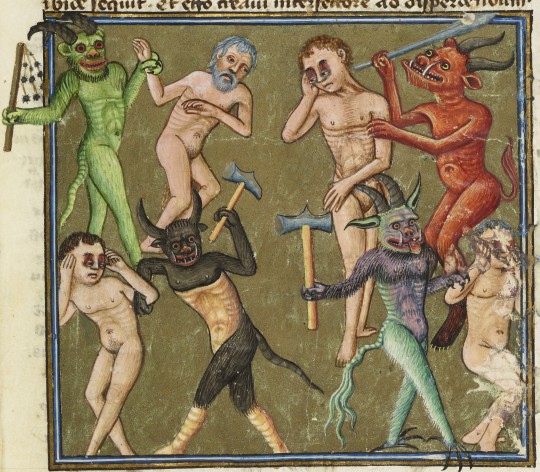
faces of hell
in the "livre de la vigne nostre seigneur", french illuminated manuscript, ca. 1450–1470
source: Oxford, Bodleian Library, MS. Douce 134, fol. 101r
417 notes
·
View notes
Text
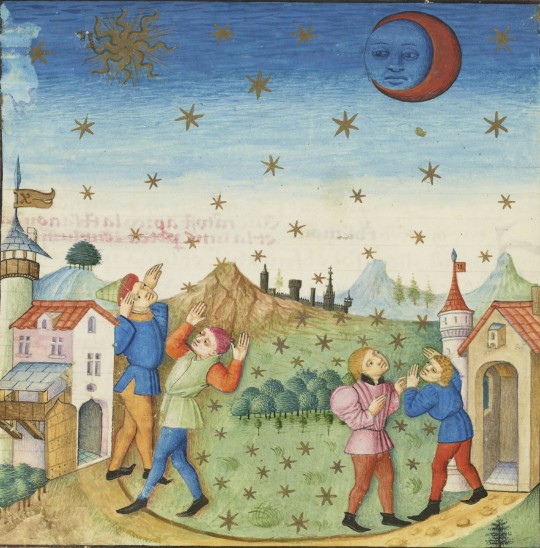
Bodleian Library MS. Douce 134 - Livre de la Vigne nostre Seigneur - fol. 37v
#manuscripts#middle ages#15th century#illuminated manuscript#medieval#medieval art#medieval manuscript#french
5 notes
·
View notes
Text
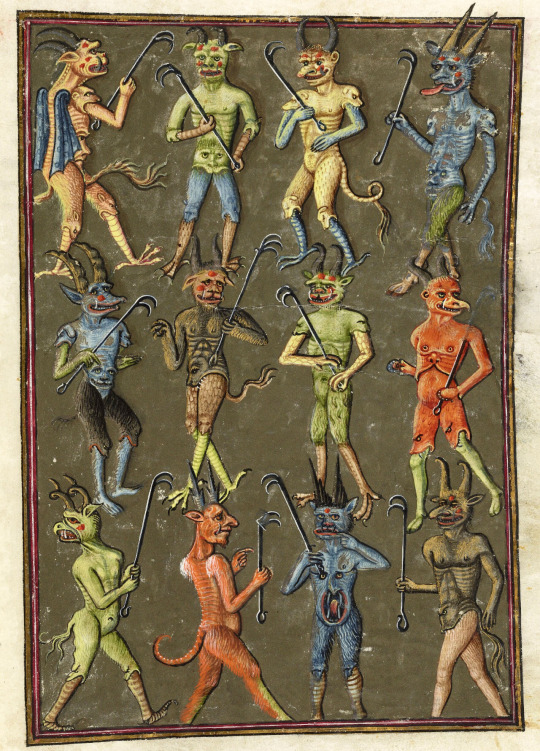
Livre de la Vigne nostre Seigneur, France c. 1450-1470
Bodleian Library, MS. Douce 134, fol. 99r
14 notes
·
View notes
Text
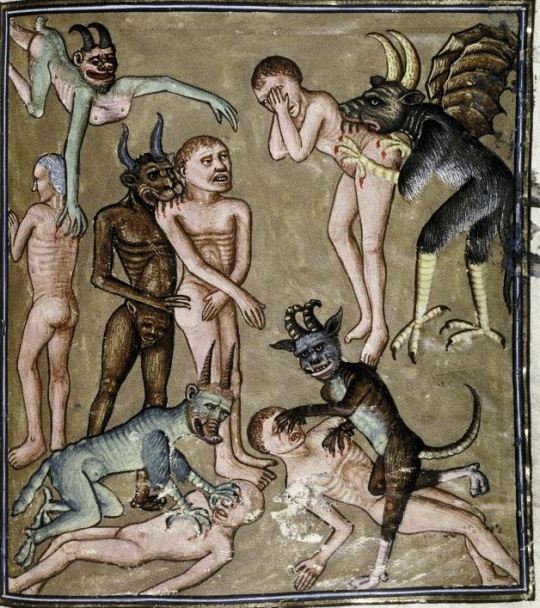
Demons Canibalism Livre de la Vigne nostre Seigneur f. 100r
Created: about 1450-1470
3 notes
·
View notes
Text
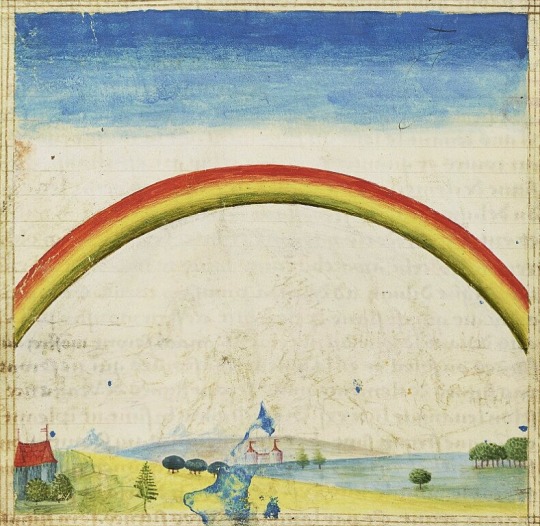
Livre de la Vigne nostre Seigneur. France ~ ca.1450-1470 Bodleian Library
0 notes
Text

Falling stars. Detail from the Livre de la Vigne nostre Seigneur, France ca. 1450-1470.
1 note
·
View note






